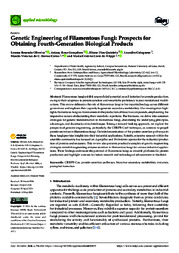Genetic engineering of filamentous fungi: prospects for obtaining fourth-generation biological products.
Genetic engineering of filamentous fungi: prospects for obtaining fourth-generation biological products.
Author(s): OLIVEIRA, L. R.; GONÇALVES, A. R.; QUINTELA, E. D.; COLOGNESE, L.; CORTES, M. V. de C. B.; FILIPPI, M. C. C. de
Summary: Filamentous fungi exhibit unparalleled potential as cell factories for protein production, owing to their adeptness in protein secretion and remarkable proficiency in post-translational modifications. This review delineates the role of filamentous fungi in bio-input technology across different generations and explores their capacity to generate secondary metabolites. Our investigation highlights filamentous fungi as frontrunners in the production of bioactive compounds, emphasizing the imperative nature of elucidating their metabolic repertoire. Furthermore, we delve into common strategies for genetic transformation in filamentous fungi, elucidating the underlying principles, advantages, and drawbacks of each technique. Taking a forward-looking approach, we explore the prospects of genome engineering, particularly the CRISPR-Cas9 technique, as a means to propel protein secretion in filamentous fungi. Detailed examination of the protein secretion pathways in these fungi provides insights into their industrial applications. Notably, extensive research within the scientific community has focused on Aspergillus and Trichoderma species for the industrial production of proteins and enzymes. This review also presents practical examples of genetic engineering strategies aimed at augmenting enzyme secretion in filamentous fungi for various industrial applications. These findings underscore the potential of filamentous fungi as versatile platforms for protein production and highlight avenues for future research and technological advancement in this field.
Publication year: 2024
Types of publication: Journal article
Unit: Embrapa Rice & Beans
Observation
Some of Embrapa's publications are published as ePub files. To read them, use or download one of the following free software options to your computer or mobile device. Android: Google Play Books; IOS: iBooks; Windows and Linux: Calibre.
Access other publications
Access the Agricultural Research Database (BDPA) to consult Embrapa's full library collection and records.
Visit Embrapa Bookstore to purchase books and other publications sold by Embrapa.

